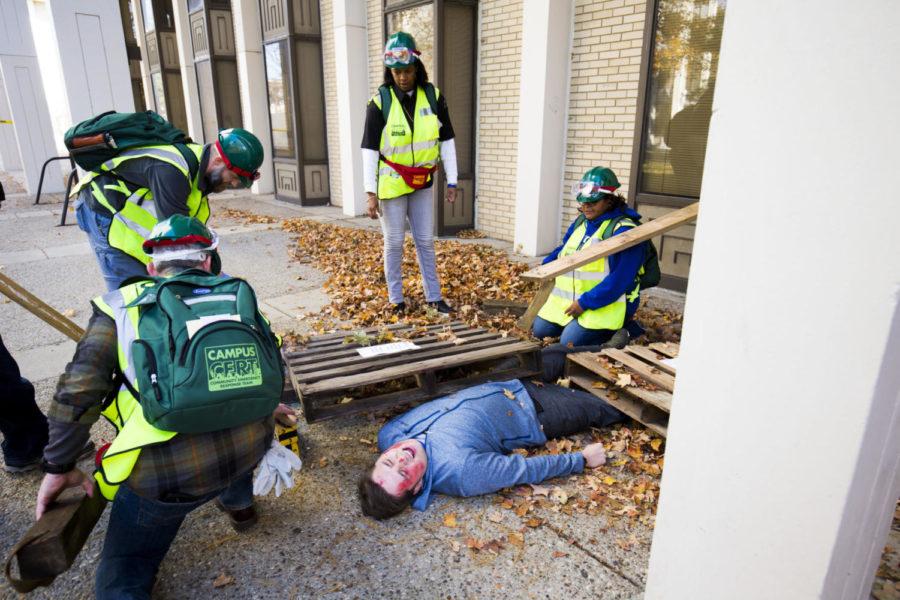C-CERT exercise simulated earthquake with injuries on campus
C-CERT members react to a victim trapped under debris during the Campus Community Emergency Response Team exercise near Kirwan IV on south campus on Thursday, November 9, 2017 in Lexington, Kentucky. The UK Police Department’s Division of Crisis Management & Preparedness offers the C-Cert training for UK faculty and staff. Photo by Arden Barnes | Staff
November 9, 2017
An earthquake rocked Lexington on Thursday afternoon.
Or at least it did during the Campus Community Emergency Response Team exercise that took place in and around Kirwan IV on south campus.
The UK Police Department’s Division of Crisis Management & Preparedness offers the C-Cert training for UK faculty and staff.
The five-week, 40-hour training culminated in the mock disaster exercise on Nov. 9.
The simulated earthquake was meant to cause damage across Lexington and created a mass casualty simulation on campus, with more than 50 “victims” scattered in the courtyard and inside the building, which is now an unused dorm.
This was the largest C-CERT exercise ever held in Fayette County, according to UKPD Emergency Management Specialist Clayton Oliver.
Previously, the exercise has been held in Memorial Coliseum.
UKPD Business Continuity Coordinator Laurel Wood said the new location required more search and rescue, with reduced visibility.
She said the new location definitely added value to the exercise.
The victims were played by UK and Eastern Kentucky University nursing students.
C-CERT members wore neon yellow vests and worked to rescue all of the victims, who were volunteers. Most of the victims, who were acting as UK faculty or students, received moulage, or wound makeup, to make the situation more realistic.
The volunteer victims were given cards that gave them instructions on how to act during the disaster. Instructions ranged from being calm to unconscious to hysterical.
A medical area was set up as a triage, where C-CERT members evaluated the severity of victims’ injuries and treated them. Some victims were uninjured and were able to help others. Other had to be escorted or even carried to the medical area.
Responders tagged victims with colored wristbands according to the severity of their injuries.
Not all of the victims survived the simulation. EKU nursing student Katherine Gordon was a victim who ended up dying within the exercise.
She was originally tagged as red, meaning she had a serious injury, but by the time a responder returned to her, she had to be tagged black, meaning she was dead.
“It was so much fun,” she said. “I loved getting all gory. I would do it again.”
The exercise was cut short when one of the C-CERT members accidentally went out an emergency door, which set of a security alarm. All people then had to clear the building.
After the exercise, the C-CERT leaders held a debrief with members and victims to evaluate how it went.
Tony Day, one of the C-CERT members who played the role of incident commander, spoke about how he thought the exercise went.
“I think it pretty much worked, for the most part,” he said.
He said he thought the team sized up the situation pretty well.
“Everyone did a great job of working with me when I was asking you to do stuff as a team,” he said.
Participants discussed specific things that went well and that could have gone more smoothly.
After the debrief, the C-CERT members were awarded certificates and ID badges for completing the program.
The program takes place each fall.
































































































































































